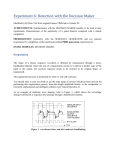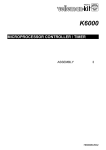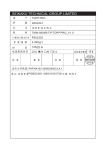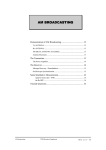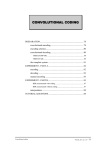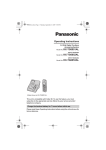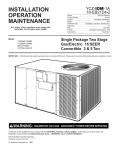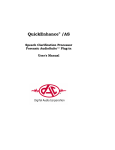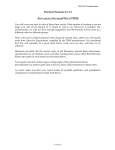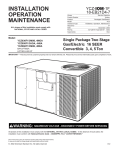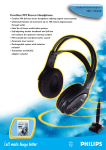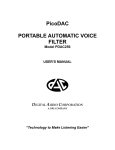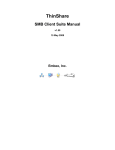Download BIT CLOCK REGENERATION
Transcript
BIT CLOCK REGENERATION PREPARATION................................................................................. 24 synchronization ......................................................................... 24 stolen bit clock .........................................................................................24 regenerated bit clock ................................................................................25 jitter..........................................................................................................26 BIT CLOCK REGEN module................................................... 26 procedure................................................................................... 27 bit clock quality......................................................................... 28 system performance................................................................... 28 EXPERIMENT ................................................................................... 29 bit clock recovery - method #1.................................................. 29 adding noise .............................................................................................30 bit clock ‘quality’ .....................................................................................30 bit clock recovery - method #2.................................................. 31 bit error rate............................................................................... 32 TUTORIAL QUESTIONS ................................................................. 33 APPENDIX......................................................................................... 34 digital delay ............................................................................... 34 divide-by-2 ................................................................................ 34 Bit clock regeneration Vol D2, ch 3, rev 1.3 - 23 BIT CLOCK REGENERATION ACHIEVEMENTS: introduction to bit clock regeneration. Evaluation using bitby-bit comparison with system bit clock. PREREQUISITES: completion of at least some of the early experiments of Volume D1. ADVANCED MODULES: BIT CLOCK REGEN, LINE-CODE ENCODER, ERROR COUNTING UTILITIES, INTEGRATE & DUMP. A BASEBAND CHANNEL FILTERS module is optional. TRUNKS: optional 208 kHz sine. Refer Laboratory Manager. PREPARATION synchronization Receivers in a digital environment can require synchronization at at least three different levels: • carrier synchronization (in the case of bandpass signals) • bit synchronization (at baseband) • frame synchronization (at baseband) This experiment is concerned with the second of these. It assumes either that the signal has been transmitted at baseband, or successfully recovered from a higher frequency carrier from which it has been demodulated. stolen bit clock For most TIMS experiments, when a bit clock is required by a receiver, it has been convenient to use a ‘stolen’ clock. Bit clock regeneration from the received data stream itself is not a trivial exercise, and is best avoided in the laboratory if at all possible. This eliminates unnecessary complications, and sources of signal corruption, and allows one to concentrate on other aspects of one`s investigations. 24 - D2 Bit clock regeneration regenerated bit clock Bit clock regeneration cannot be avoided in a real-life situation. Techniques can be divided into two fundamental types: open loop, and closed loop. This experiment is concerned with very basic open loop techniques. open loop If there is already a component at the bit clock frequency in the spectrum of the data stream, it can be extracted with a bandpass filter (BPF). Alternatively, there may be a component at a higher harmonic; this, instead, could be extracted, and the fundamental obtained by division. Figure 1 illustrates the basis of the most elementary example of an open loop system, where a component at bit clock frequency already exists in the data. incoming data BPF sine to TTL Figure 1: example of elementary open loop bit clock extraction When there is no component at bit clock frequency or any of its harmonics it can probably be created by a non-linear element, as shown in Figure 2. incoming bandlimited data non-linear element BPF harmonic of bit clock PLL DIVIDER Figure 2: creation, and extraction, of a spectral component at bit clock frequency TIMS non-linear elements in this context are: • a MULTIPLIER (used as a squarer) • the CLIPPER, in the UTILITIES module For example, the spectrum of a bipolar pseudo random binary sequence from the SEQUENCE GENERATOR is of the form shown in Figure 3(a) below. Notice that there are nulls at all the harmonics of the bit clock frequency (2.0833 kHz). If this signal is first bandlimited, then squared, the spectrum, Figure 3(b), now contains lines at the bit clock frequency and its harmonics. A component at the bit rate can be extracted with, for example, a bandpass filter (BPF – see the BIT CLOCK REGEN module), or a phase locked loop (PLL) – or perhaps a combination of the two. Bit clock regeneration D2 - 25 (a) (b) Figure 3: PRBS signal spectrum (a) before and (b) after bandlimiting and squaring closed loop Closed loop circuits use feedback. They make comparisons with received data and expected data. They can involve the transmitter sending known sequences training sequences - which are used by the receiver to verify synchronization 1. Closed loop systems are more accurate than open loop systems, but can be complex and costly. They are outside the scope of present TIMS modules. jitter Bit clock recovery circuits can suffer from timing jitter. Although the recovered clock is of the correct mean frequency, it can be undergoing either or both of linear and non-linear modulation. The effects of linear modulation can be removed (or at least reduced) by amplitude limiting - by a comparator, for example. The effects of non-linear modulation are not so easily overcome. BIT CLOCK REGEN module This is the first time the BIT CLOCK REGEN module has been used. It is described in detail in the Advanced Module User Manual. As can be seen, from the drawing of the front panel (opposite), the module contains four independent subsystems. These have been described separately in the Chapter entitled Digital utility sub-systems (in this Volume) to which you should refer. DIVIDE BY n TRANS. DET LOOP FILTER DUAL BPF As its name implies, these sub-systems are useful in bit clock regeneration schemes, examples of which are given in the experiment to follow. clk You may also devise your own schemes. 1 recall the operation of the sliding window correlator for sequence alignment 26 - D2 Bit clock regeneration procedure Some of the signal formats available from the LINE-CODE ENCODER module can be used to test bit clock recovery schemes. There are only two examples of bit clock recovery scheme given in the experiment to follow - one in detail, and the other in outline. When completed, you are invited to investigate other methods of recovery in which you are interested. In preparation, here are some reminders of signals and systems which may be useful. signal source As already mentioned, the LINE-CODE ENCODER, driven by a SEQUENCE GENERATOR at 2.084 kHz, is a good source of bit streams having different characteristics. These serve as inputs to your bit clock regenerator, after passing through a noisy, bandlimited channel. modules The following modules will be found useful in the work to follow: • • BIT CLOCK REGEN module: not surprisingly, this module will be useful ! UTILITIES module: contains a CLIPPER/COMPARATOR - a useful odd-order non-linear characteristic, and used for converting a sinewave to TTL format. • • a MULTIPLIER, as a SQUARER, provides an even-order non-linear characteristic. • • NOISE GENERATOR: a low SNR will put your regeneration system to the test. VCO: as part of a phase locked loop (PLL). There is a loop filter in the BIT CLOCK REGEN module, as well as a TTL divide-by-two sub-system. the INSTRUMENTATION MODEL macro module will check BER performance, although a simplified bit clock ‘quality’ arrangement is suggested. bit clock component present ? Before modelling a regeneration scheme, it might be a good idea to examine each of the line codes to check whether it already has a bit clock component present in its spectrum. This can be done with the scheme of Figure 1. bit clock component creation For those spectra not already containing a spectral line at bit clock frequency try a scheme as illustrated in Figure 2. BIT CLOCK REGEN BPF Using an internal clock, the BPF in the BIT CLK REGEN module may be tuned to 2.048 kHz. It may be tuned to other frequencies by the use of an external sinusoid (eg, a VCO). For example, to tune the BPF to 4.167 kHz (twice 2.048 kHz) requires a clock at 50 times this frequency, namely 208.33 kHz. This frequency may be obtained from: 1) a VCO: a) by setting the on-board switch SW2 to FSK b) toggling the front panel switch to HI Bit clock regeneration D2 - 27 c) leaving nothing connected to DATA IN (acceptable as a TTL LO) d) adjusting RV7 (FSK1) for 208 kHz output (setting the frequency to 208 kHz by watching the frequency counter is acceptable. However it may be easier to connect a 4.167 kHz sine wave to the input of the BPF and then to tune the VCO for a maximum BPF output). or 2) TRUNKS. This would be the preferred option. bit clock quality Rather than measure bit error rate over a noisy channel - which tests the complete system - it is instructive to measure just the ‘quality’ of the recovered bit clock. The term ‘quality’ is used loosely here. It refers to frequency and phase stability, jitter, and so on. See Tutorial Question Q5. A method of measuring the quality consists of comparing the regenerated clock with the system clock, using the X-OR in the ERROR COUNTING UTILITIES module, as a performance indicator. A suggested arrangement is shown in block diagram form in Figure 4 below. The phase of the sinusoidal output from the BPF is made adjustable so it may be aligned with the reference bit clock. A digital VARIABLE DELAY is inserted in the gate to the X-OR to control the instant of comparison. LINE CODE PRBS NOISY BANDLIMITED CHANNEL PHASE BIT REGEN CIRCUITRY A X - OR errors B gate TTL DIGITAL DELAY BIT CLOCK Figure 4: measurement of bit clock quality By appropriate adjustment of the analog phase and the TTL delay, and with no noise, the arrangement can be set so as to register no errors. Noise could then be added to the channel in order to make a more demanding test. Reliable bit clock recovery should be possible for signal-to-noise ratios approaching 0 dB. This system will be modelled in the experiment. system performance If the quality of the recovered bit clock is considered good, by the previous test, then the overall system performance can be measured by carrying out a bit error rate measurement over the noisy channel. This is perhaps an unnecessary extension of the experiment, the aim of which was to introduce some basic methods of bit clock recovery, without going into great detail. 28 - D2 Bit clock regeneration EXPERIMENT The complete system to be modelled involves many modules. It will be patched up systematically. It is suggested that the modules be inserted into the TIMS frame in the order shown, starting at the extreme left hand side. In the first example a bit clock will be recovered from the UNI-RZ coded output from the LINE-CODE ENCODER. This waveform may be shown to contain energy at the bit clock frequency. So it can be extracted with a BPF according to the scheme of Figure 1. bit clock recovery - method #1 T1 acquire a BIT CLOCK REGEN module. Read about it in the Advanced Modules User Manual. Before plugging it in locate the on-board switch SW1. Set the left hand toggle UP and the right hand toggle DOWN. This tunes BPF #1 to 2.083 kHz, and leaves BPF #2 to be tuned by an external TTL signal (at 50 times the desired passband frequency) later on in the experiment. T2 patch up the diagram of Figure 5, which is a model of the open loop regeneration scheme of Figure 1. TTL bit clock out 8.333 kHz MASTER Figure 5: model of Figure 1 T3 using the 2.083 kHz as a reference on CH1-A, look at the output of BPF #1 with CH2-A. This will be a sinewave, also on a mean frequency of 2.083 kHz. However, its amplitude will be varying with time. Is this due to amplitude modulation or phase modulation ? See Tutorial Question Q1. T4 observe the output of the COMPARATOR on CH2-B. This is a TTL signal, of fixed amplitude, and mean frequency 2.083 kHz. Is its phase varying ? Bit clock regeneration D2 - 29 adding noise The above procedures demonstrated carrier regeneration from a wideband, noisefree signal. Now pass the test signal through a noisy, bandlimited channel. T5 add a noisy, bandlimited channel 2 to the model, as in Figure 6 below. Use a TUNEABLE LPF as the bandlimiting filter, or channel #3 of a BASEBAND CHANNEL FILTERS module. Without noise, adjust the gains of the TUNEABLE LPF (bandwidth set to maximum) and each ADDER to unity. Include the PHASE SHIFTER; it will be required later. Confirm the regenerated carrier is still present at the output of the COMPARATOR. T6 add noise. Estimate at what level of SNR the recovered bit clock might become unusable ? Explain how you made this estimate. TTL bit clock out 8.333 kHz MASTER Figure 6: adding a noisy channel bit clock ‘quality’ Now add some instrumentation to measure the ‘quality’ of the recovered clock. T7 add the error counting facility shown in Figure 7 below. This is based on the scheme illustrated in Figure 4. As shown, the regenerated bit clock is patched to the ‘A’ input f the X-OR gate, and the reference (the system bit clock) into the ‘B’ input. 2 described in the experiment entitled The noisy channel model in Volume D1. 30 - D2 Bit clock regeneration COUNTER GATE ERROR COUNTER 8.333 kHz MASTER Figure 7: the system with instrumentation added T8 first check performance of the error counter with the system bit clock in both inputs ‘A’ and ‘B’. T9 when happy with the previous Task, remove the noise, and replace the stolen bit clock with the regenerated bit clock. Check the alignment of the XOR inputs. Adjust the DIGITAL DELAY. Adjust the DIGITAL DELAY for no errors 3. This must be possible ! For the record observe the timing of the gating pulse from the DIGITAL DELAY to the X-OR clk with respect to the X-OR inputs (and the range over which it may be moved for no errors to be recorded). Describe in your notes what you understand by the statement ‘adjust the digital delay’. T10 now patch the regenerated bit clock into the ‘A’ input of the X-OR gate (not via the DIGITAL DELAY). Align the two inputs to the X-OR gate with the PHASE SHIFTER (on-board switch set LO). Adjust the DIGITAL DELAY for no errors. T11 with no errors the recovered clock should be of acceptable quality. Now add noise, and report results. Record in your notes your opinion regarding the validity of the ‘quality’ measurements. bit clock recovery - method #2 The previous bit clock recovery method extracted a component at bit clock frequency which was already present in the data stream. This second method is truly a regenerative method, since the data stream will not have such a component present. 3 for details of range setting of the DIGITAL DELAY see the Appendix to this experiment. Bit clock regeneration D2 - 31 It will model the block diagram of Figure 2, using a MULTIPLIER as a squarer. The model is shown in Figure 8 below. It is complete with recovered bit clock ‘quality’ assessment instrumentation. Detailed step-by-step Tasks are not provided. COUNTER INPUT COUNTER GATE 8.333 kHz MASTER Figure 8: the TIMS model You will note that the model contains 13 plugin modules (there are five within the CHANNEL MODEL macro module - but one, the VARIABLE DC, is a fixed module so does not require a free slot). These 13 cannot be accommodated within a single TIMS 301 system. However, if you use a QUADRATURE UTILITIES module which contains two MULTIPIERS, then there is sufficient space in a single TIMS 301. The BPF in the BIT CLOCK REGEN module must be tuned to 2.083 kHz by setting the on-board switch SW1 to INT CLK. The second MULTIPLIER, together with the VCO and LOOP FILTER in the BIT CLOCK REGEN module, implements a phase locked loop (PLL). You might query the need for this, since the output of the BPF is already a sinusoid at this frequency (the sinusoid could be converted to TTL, as required by the EXCLUSIVE-OR gate in the ERROR COUNTING UTILITIES, with the COMPARATOR in the UTILITIES module). Consider the merits of both systems, and try each as time permits. bit error rate A final check of the quality of any bit clock recovery scheme would consist of measuring the bit error rate of the overall system under different conditions. TIMS can do that, following the procedures set out in the experiment entitled BER measurement in the noisy channel (in this Volume). It would call for a second TIMS 301, or a TIMS Junior, to accommodate the extra modules. It would also go beyond the intended aim of the experiment, which was to introduce some elementary schemes of bit clock recovery. 32 - D2 Bit clock regeneration TUTORIAL QUESTIONS Q1 a bit clock, recovered as a sine wave with varying amplitude, may or may not have uniform zero crossings. Give examples of the two cases. Which one gives rise to timing jitter ? Q2 how would the presence of timing jitter (in your extracted clock) show up on the oscilloscope ? Q3 can you distinguish, using only the oscilloscope, the difference between amplitude jitter and phase jitter on a regenerated clock bit ? Q4 what factors might influence the choice between an open loop and a closed loop bit clock regeneration scheme ? Q5 describe the various imperfections from which a recovered bit clock can suffer. Bit clock regeneration D2 - 33 APPENDIX digital delay The DIGITAL DELAY sub-system is built into the INTEGRATE & DUMP module. It is described in the Advanced Modules User Manual, as well as in the Chapter entitled Digital utility sub-systems of this Volume. The delay is adjustable by a front panel control DELAY, in conjunction with a toggle switch SW3 mounted on the circuit board. The delays to be expected are shown in the table below. SW3-upper toggle SW3-lower toggle delay range from front panel, using DELAY RIGHT RIGHT 10 µsec - 100 µsec RIGHT LEFT 60 µsec - 500 µsec LEFT RIGHT 100 µsec - 1 msec LEFT LEFT 150 µsec - 1.500 msec on-board switch SW3 settings The bit clock in the present experiment is 2 kHz, so the period is 500 µs. divide-by-2 There is a TTL divide-by 1, 2, 4, or 8 in the BIT CLOCK REGEN module. The onboard switch setting s are shown in the Table below. SW2-A (left) SW2-B (right) divide by DOWN DOWN 8 DOWN UP 4 UP DOWN 2 UP UP -1 on-board switch selectable division ratios 34 - D2 Bit clock regeneration














